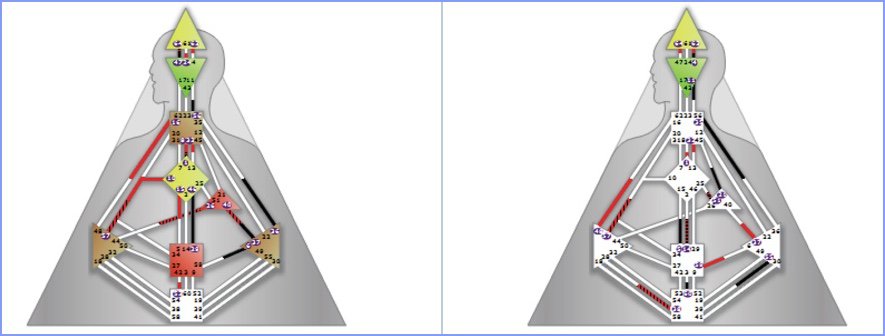Rank and Dominance in Relationship

I spent some time exploring and studying psychotherapy before discovering Human Design. Many of the tools and practices I learned have served the de-conditioning process and also shown me what this system has to offer. Once the daily necessities of mundane life and survival are addressed, it seems that a high quality therapist or spiritual teacher focuses on helping a client discover authenticity and true nature. Human Design focuses on accessing and following nature as well, however, it offers us a highly detailed map which can accelerate and simplify the process.
Once we are able to see the different aspects of our nature clearly, we can come to recognize that much of what we may have viewed as difficult and persistent traits, are actually consistent gifts or abilities that have been pathologized or applied to life indiscriminately. We can also see that much of what we have tried to fix or improve in ourselves is actually designed to be accepted as an area of inconsistency or vulnerability that may always be that way.
We are deeply conditioned by morality. The moralities of our families, our cultures, religions, and the subcultures and social groups in which we find ourselves. Nearly all of these structures and institutions have an assessment of what is good and bad, in thought, belief, behavior and expression. If we look deeply into Human Design, it provides a map which is logical, mechanical and amoral. For example, we can look at the detriment of any line for any gate and see what could be interpreted as a negative trait. And yet there is an application for it, a context in which it could be correct for that trait to occur. What we gain through the practice of Strategy and Authority, is the opportunity to stop allowing our minds to interfere with the body’s awareness and the ability to detect the right context in which our nature can express itself without resistance.
 Looking at relationships through the lens of design, we can see distinctive traits in the mechanics of the relationship and how the mind can interfere with seeing the relationship clearly through a Connection chart. We can also strengthen our communication and mutual respect greatly through becoming aware of the differences between the designs of each individual. One of the benefits of studying design beyond our own personal map is to develop the capacity to see into and respect the nature and conditioning impacts on the other, as well as what is fixed and conditioned in the relationship itself. For example, having an Open Ego Center in an individual design makes us more likely to question our worth and value. Having an Open Ego Center in a Connection Chart makes the individuals more likely to doubt the value of the relationship or to become fixated on trying to improve it or prove that it has value.
Looking at relationships through the lens of design, we can see distinctive traits in the mechanics of the relationship and how the mind can interfere with seeing the relationship clearly through a Connection chart. We can also strengthen our communication and mutual respect greatly through becoming aware of the differences between the designs of each individual. One of the benefits of studying design beyond our own personal map is to develop the capacity to see into and respect the nature and conditioning impacts on the other, as well as what is fixed and conditioned in the relationship itself. For example, having an Open Ego Center in an individual design makes us more likely to question our worth and value. Having an Open Ego Center in a Connection Chart makes the individuals more likely to doubt the value of the relationship or to become fixated on trying to improve it or prove that it has value.
I once attended a relationship workshop based on Process Work, a depth psychology theory and method developed by psychologist Arnold Mindell. One of the exercises involved examining rank in relationship, which is a way of understanding how hierarchy works in personal and group dynamics.
In this exercise, we paired up with our significant others and made a list of as many areas we could think of where we could assess rank, meaning who had higher or more advantageous standing or capacity in that category. Categories included gender, race, class, economic status, and education as well as intelligence, emotional awareness, resilience, physical strength, health, and physical attractiveness. We also noted whether these rankings were earned versus given or naturally endowed to each person at birth.
The instruction was to recognize that in each area, the person of higher rank had an advantage in access and/or ability that could offer some learning or growth to the person of lower rank. It involved the person of lower rank accepting that the higher rank person had greater capacity in this realm. Those of higher rank were encouraged to recognize that they could easily take their endowment in that area for granted and treat it as if it is “normal”.
 In the areas where we have higher rank, especially if that rank was not earned, we are constantly challenged to recognize that we have no idea what it is like to experience the lack of that advantage. We have no experience of the pain associated with it or the challenge involved in overcoming it. We may have to step far outside of ourselves to become aware of what it would be like to not have what we have always had.
In the areas where we have higher rank, especially if that rank was not earned, we are constantly challenged to recognize that we have no idea what it is like to experience the lack of that advantage. We have no experience of the pain associated with it or the challenge involved in overcoming it. We may have to step far outside of ourselves to become aware of what it would be like to not have what we have always had.
Those with lower rank tend to be less confident or comfortable speaking out, more unstable or out of control in expression, and often even viewed as unreasonable or crazy. In general, the traits that are less dominant or less valued culturally are pathologized and subtly or overtly influenced to become homogenized to the dominant traits within a culture.
The other side of how we relate to what we take for granted is that we often don’t see the value of it. We tend to see our advantage as a baseline of experience. It is so consistent that we don’t see that it is a privilege that is of value. It is easy to not appreciate what we have always had and to assume that others have it as well.
In terms of Human Design, we can see a corollary of this rank concept in the mechanics of design. If we have definition in a way that someone else doesn’t, we don’t really know what it’s like to live with the pressure and the pain of the instability and conditioning of that openness. We also don’t have access to the breadth and flexibility of experience in that open center or channel, which can ultimately become a source of wisdom. The other can learn from the fixedness of what we are and perhaps even bring clarity to the value of our fixedness in a way that we take for granted.

These designs are an example of a relationship I recently encountered. On the left, we see a triple split Emotional Manifesting Generator and on the right a single definition Mental Projector. Dominance in Human Design relationship analysis refers to a channel that is defined in one design where there is no definition of any part of that channel in the other. It is often an area where we can see the gift of that definition and appreciate it with some neutrality or objectivity. We could expand the concept at the surface by considering the Centers that are defined in one chart where they are open in the other. Before even looking at the Connection Chart, however, we can learn a lot about this relationship.
What do they have in common? They are both designed to wait, for response and for invitation. Both are designed to take their time in making major decisions and can benefit from noticing what happens when they feel pressured to initiate and act spontaneously. Both have fixed minds that process mental information and inspiration in their own ways. Both have open Root centers and have the potential to deal with stress and drive in a variety of ways, as well as an inconsistency in terms of drive and a vulnerability to the pressure to do more faster in order to relieve the sense of pressure to act. A shared Open Center is a potential window through which we can learn about life together without a particular fixation.
The Generator has 6 centers defined that the Projector has open. This could be seen as a kind of rank in all of these areas. The consistent access to life force through the defined centers naturally gives the Generator a stability and advantage when dealing with the themes of these centers: access to energy, ability to work consistently, willpower, handling emotional energy and confrontation, sense of well being and intuitive clarity, communicating and expressing oneself and sense of identity and direction. In addition, the Generator type is most common and the valuing of power and work as a means of engaging with life is a collective norm. Productivity tends to be valued over presence and awareness, which is more of the natural inclination for Projectors.
The Projector could be seen as highly variable in all of these realms, dependent on people, places and context. If this is a domestic relationship in which there is a lot of contact, the Projector could seem quite capable in all of these ways, through absorbing the conditioning and amplifying the definition of the Generator. This Projector may be more sought after in relationships generally, being seen as flexible, focused on others and intelligent, which can be a kind of advantage socially even if it does not necessarily serve the fulfillment of the Projector. If these are adults, then conditioning is certainly a factor for both of them in different ways. The Generator may see herself, in terms of her emotions, behavior, response, voice and will, reflected in this Projector. The Projector may feel fueled and stabilized by this conditioning influence as well as fixed and pressured by it.
Without knowing about design, how do these individuals tend to interact with each other? What do they take personally about the natural traits of the other? What do they expect of the other given their own definition? What could each of these individuals gain by seeing these design similarities and differences? What would it mean to allow and respect their own nature and that of the other?
Relationship analysis can be used to further awareness, respect, acknowledgment of truth and communication. We can see a lot in terms of mechanics and yet still it does not tell us whether or not the relationship is healthy or correct for the individuals. If we consider that most relationships are created out of not-self motivations, we can imagine the inner work it takes to see the relationship for what it is.
Many of us fail to fully love and accept ourselves. It can be hard to even see ourselves clearly. So when we look at personal relationships and partnerships, it’s easy to see why it can be hard to accept and love others as they are, or to think there is something wrong with the relationship if it does not conform to the limited forms and standards of common conditioning. Relationships have the potential of being remarkably unique and varied. Human Design offers two powerful tools for recognition and de-conditioning in relationship. One is a way of seeing the mechanics of our interactions with each other, the nature of things, over which we have little, if any, control. The other is a way of determining whether or not the relationship is correct for us, through listening to the intelligence of our bodies, through Strategy and Authority.

